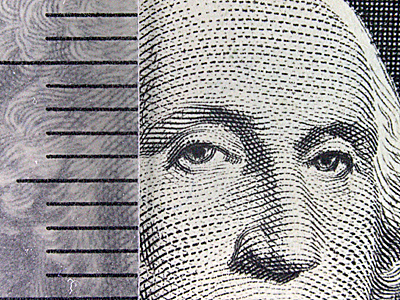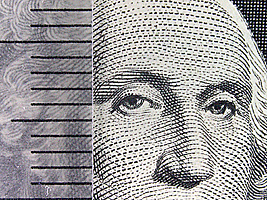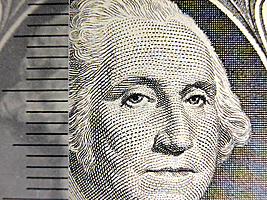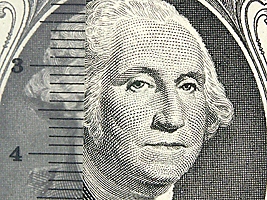The magnification of a lens means how large (or small) a subject can be reproduced on the image plane (e.g., film and image sensor). The definition of magnification is very simple. If a subject of length X forms an image of length Y in the image, the magnification of the lens is defined to be Y/X. This is the lateral magnification of a lens, which is commonly used for close-up and macro photography, because it only measures in one dimension. For example, if a subject of length 10mm has a length of 2mm on the image, the magnification of the lens is 2/10=0.2. If a lens can produce a magnification equal to 1, we will say it can deliver a life-size image; and if the magnification is larger (resp., smaller) than 1, we will say it delivers a larger (resp., smaller) than life-size image. Note that magnification does not depend on the film frame size and sensor size since it is a lens characteristic. For example, the Nikon AF 60mm F2.8D Micro is capable of life-size magnification on a Nikon film camera. If this lens is used with an APS size Nikon DSLR body such as D2H, D100 and D70, it still delivers a life-size magnification.
Normally, the magnification of a lens is written in a slightly different form rather than as a single number. If the magnification is Y/X, where Y and X are image length and subject length, respectively, the commonly used form is first written as Y:X. Thus, the example discussed in the previous paragraph has a magnification of 2:10. Sometimes, we also divide both X and Y by either X or Y to obtain a form like 1:Y/X or a form like X/Y:1. Thus, 2:10 may also be rewritten as 1:5 or 0.2:1. The life-size magnification is rewritten as 1:1, and 2:1 and 1:2 are larger than and smaller than life-size, respectively. Conversely, when we see a magnification value like 3:4, we know that it is equal to 3/4=0.75X, which is smaller than life-size. Similarly, a magnification of 5:2 is equal to 5/2=2.5X, which is larger than life-size.
In order to find out the maximum magnification of your camera/lens, the first thing to do is to find out the sensor size. We mentioned earlier that magnification is sensor size independent. But, why is sensor size needed? The answer will be clear very soon.
Here is the first step. Open your camera manual and find out what type of sensor your camera has. Your camera manual may simply tell you the sensor is 1/2.7" (e.g., Coolpix SQ and Coolpix 3500), 1/1.8" (e.g., Coolpix 4500), or 2/3" (e.g., Coolpix 5000 and Coolpix 5700). These size values are actually the so-called tube size rather than the actual sensor size. If we use the tube size in our calculation, the error may be around 40% to 50%. Although this error rate may not have a significant impact on actual macro shooting, we would prefer to use the actual sensor size. Any good electronic sensor book will provide you with a table showing the relationship between tube size and the actual sensor size. Here are two handy sites for you to get this information: DP Review and Digital Outback Photo. Here are commonly seen sizes:
| Tube Size | Sensor Size | Cameras |
| 1/3.2" | 4.536×3.416 | Canon A100, A200 |
| 1/2.7" | 5.27×3.96 | Minolta X, Xi; Nikon SQ, 3500 |
| 1/2" | 6.4×4.8 | Nikon 950 |
| 1/1.8" | 7.176×5.319 | Nikon 995, 4500; Olympus C5050 |
| 2/3" | 8.8×6.6 | Sony 717, Minolta 7Hi, A1; Nikon 5000, 5700 |
| APS | 23.7×15.6 | Nikon D100, D1X |
The next step is taking a picture with a ruler clearly shown in the horizontal or vertical position. Note that the camera should be in macro mode and should be moved back and forth until the image is the largest. The following image was taken with a 5700 when the magnification is the highest. Then, we count how many millimeters are covered in the image. The image below covers about 21.5mm. This means a subject of length 21.5mm has an image length equal to the vertical dimension of the image sensor. In this case, the vertical dimension of the 5700 sensor is 6.6mm.

Therefore, the subject length of 21.5mm has an image length of 6.6mm in the image, and the magnification is 6.6/21.5 = 0.31X, or 1:3.26. In other words, the 5700 has a magnification about 0.31X.
The following summarizes what you need to do in order to figure out the magnification your camera has:
Let us use a few examples to illustrate the calculation of magnification of a number of Coolpix cameras. The following image was taken with a Coolpix 4500. Note that the 4500 does not have the highest magnification in the macro mode (i.e., yellow flower icon). Instead, the maximum appears when the lens is zoomed in a little bit passing the "macro zone." The focal length used to take the following image is 19.8mm, which translates to 95.89mm in the 135mm equivalent. This image shows that the vertical direction records about 12.5mm. Since the 4500 has a sensor of type 1/1.8" that has a sensor dimension of 7.176×5.319mm, the magnification is 5.319/12.5 = 0.43X or 1:2.35. This magnification is higher than that of the 5700 (i.e., 0.31X). Therefore, in terms of magnification, the 4500 is better than the 5700 (i.e., 0.43X vs. 0.31X).

The following image was taken with a Coolpix 5000 at its nearly maximum magnification. It records 18.5mm along the vertical side. Since the Coolpix 5000 has a sensor size of 8.8×6.6, the magnification is 6.6/18.5 = 0.36X, or 1:2.8. Therefore, in terms of magnification, the 4500 is better than (i.e., 0.43X) the Coolpix 5000 (i.e., 0.36X), which, in turn, is better than the 5700 (i.e., 0.31X). This may explain why people consider the Coolpix 4500 as the king of macro.

The following image was taken by a Konica Minolta A1 with lens set to 200mm (35mm equivalent), and locked in the macro mode. The A1 has a sensor size of 8.8×6.6mm. The image below shows that the vertical direction records about 23mm. Therefore, the magnification is 6.6/23 = 0.29X, or 1:3.8, and Konica Minolta A1's magnification is slightly lower than that of the Coolpix 5700.

The following image was taken by a Nikon D100 with a Nikon AF 60mm F2.8D Micro lens that is capable of 1:1 life-size. The recorded "height" is about 15.5mm on the image. Since the "height" of the D100 sensor is 15.6mm, we see that the magnification is 15.6/15.5 = 1X, or 1:1. This illustrates an important fact that magnification is a lens characteristic and independent of the image size.

The following table summarizes the magnification results.
| Camera+Lens | Recorded Length | Magnification |
| Coolpix 4500 | 12.5mm | 0.43X or 1:2.35 |
| Coolpix 5000 | 18.5mm | 0.36X or 1:2.8 |
| Coolpix 5700 | 21.5mm | 0.31X or 1:3.26 |
| Minolta A1 | 23mm | 0.29X or 1:3.8 |
| D100 + 60mm Micro | 15.5mm | 1X or 1:1 |
Yes, of course, there are some inaccuracies. Here are the major ones. Even though we know the sensor size, since the area used for recording an image is usually slightly smaller than the size of the sensor, the "height" value would be slightly smaller, which, in turn, makes the calculated magnification slightly lower. Moreover, the image taking task for determining the maximum magnification is basically a trial-and-error process, discrepancies may be introduced from time to time. The recorded "height" may not always be the same value, and the calculated magnification will also be affected. Fortunately, the impact of these two factors on the calculated magnification is not very significant (i.e., 0.29X and 0.31X do not have much difference in reality). If you wish to carry out the magnification calculation discussed here, you may want to take several images and choose the best one.
I am not sure if you see something odd in the above five images used for magnification calculation. The follow shows their smaller size images. Do you see anything unusual? If you examine the images below, you will see that the magnifications of 4500, 5000, 5700 and A1 are 0.43X, 0.36X, 0.31X and 0.29X. This is obvious because the images justify this fact (i.e., the image taken by the 4500 covers a smaller area than that of the 5000, etc). But, the image taken by the D100 plus a 1:1 capable 60mm Micro lens covers a larger area than that of the 4500. Is there something wrong? The answer is nothing wrong here. But, why the 4500 with a magnification 0.43X can "magnify" higher than a 1:1 life-size image taken by the D100 plus 60mm Micro lens? The answer is: the sensor size of the D100 is larger than the sensor of the 4500.

|

|

|
| 4500 (0.43X) | 5000 (0.36X) | 5700 (0.31X) |

|

|
| Minolta A1 (0.29X) | D100 + 60mm Micro (1X) |
Suppose a lens projects a given subject 1:1 life-size on an image sensor of dimension a×b. Suppose further the same subject is projected on another image sensor by a lens capable of 1:r. If the second sensor records the same coverage as the first one, the second sensor must have a dimension of (a/r)×(b/r). For example, suppose a subject projects 1:1 on an image sensor A of 3×4, and the same subject projects by a lens capable of 1:4 on another image sensor B. Then, sensor B must have a dimension of at least (3/4)×(4/4) = 0.75×1 in order to record a complete image of the given subject. Therefore, a lens of 1:r and a sensor of dimension (a/r)×(b/r) would yield the same result that a 1:1 lens and a a×b sensor can obtain. This result shows the advantage of smaller size sensors because they can achieve the same result that a 1:1 lens can get with a lower magnification.
Some authors prefer to use "coverage" as a measure of the macro capability of a camera. In the above examples, since the 4500, 5000, 5700 and Minolta A1 use a 4×3 format and the D100 uses a 3×2 format, we can easily calculate the coverage of each camera. Basically, if the image shows p mm as the "height", then the width is p×4/3. As for the DSLR case, it is p×3/2. The following table summarizes the coverage area of 4500, 5000, 5700, Minolta A1 and D100 with AF 60mm F2.8D. From this table, we learn that the D100 with a 1:1 life-size capable lens has a coverage larger than that of the 4500. This, of course, does not reflect the actual capability of the lens being used. Note that magnification can be calculated from the coverage data and sensor size. For example, since the coverage of the 5000 is 24.67×18.5 and the sensor size is 8.8×6.6, the magnification of the 5000 is 6.6/18.5 = 0.36X.
| Camera | Magnification | Recorded Height | Aspect Ratio | Coverage |
| Coolpix 4500 | 0.43X | 12.5mm | 4:3 | 16.67×12.5mm |
| Coolpix 5000 | 0.36X | 18.5mm | 4:3 | 24.67×18.5mm |
| Coolpix 5700 | 0.31X | 21.5mm | 4:3 | 28.67×21.5mm |
| Minolta A1 | 0.29X | 23mm | 4:3 | 30.67×23mm |
| Nikon D100 + 60mm Micro | 1X | 15.5mm | 3:2 | 23.25×15.5mm |
Some suggested to factor in the resolution of the sensor. Suppose the coverage and resolution of the sensor are a×b and m×n, respectively. Some suggest the use of m/a = n/b as a measure of the macro capability of a lens+sensor system and claim that higher value implies better macro. Let us examine this approach closely. The following table shows the calculated results of the five cameras mentioned above. The results look fine so far, except for the D100 case, again. Consider the Coolpix 8700. Since this camera has the same lens and sensor size (i.e., 2/3") as that of the 5700, we can assume that the coverage would be same as that of the 5700. However, since the 8700 has a resolution of 3264×2448, the pixel/mm count jumps to 2448/21.5 = 113.86. What if we use a 12mp 2/3" sensor with a resolution of 4000×3000 as a replacement of the 5700/8700 sensor? The pixel/mm count would be 3000/21.5 = 139.53, which is even higher than that of the 4500! Is there something unusual here? Yes, if we continue to pack more pixels to a 2/3" sensor, the pixel/mm count increases, and, as a result, the "macro" capability in this sense increases even though the lens magnification and image coverage do not change. Therefore, this is a problematic definition because macro capability does not come from pixel count. Those who promote this pixel/mm count as a measurement of macro capability usually have an argument like this: one can crop part of the image, because the increase of pixel count cropping would increase the magnification. Unfortunately, cropping is not part of the equation of magnification. Otherwise, one does not need any macro lens. A very high density and small sensor would do all the magic of an excellent macro lens.
| Camera | Magnification | Coverage | Resolution | Pixels/mm |
| Coolpix 4500 | 0.43X | 16.67×12.5 | 2272×1704 | 136.32 |
| Coolpix 5000 | 0.36X | 24.67×18.5 | 2560×1920 | 103.78 |
| Coolpix 5700 | 0.31X | 28.67×21.5 | 2560×1960 | 89.30 |
| Minolta A1 | 0.29X | 30.67×23 | 2560×1960 | 83.48 |
| Nikon D100 + 60mm Micro | 1X | 23.25×15.5 | 3008×2000 | 129.03 |
There are other problems with the "pixel/mm count" approach. Both take the image device into consideration, while the traditional magnification approach is image device independent. Recall that a lens of 1:r magnification needs a sensor of size (a/r)×(b/r) to produce an image of a subject of size a×b, while a 1:1 life-size lens can produce the same subject on a sensor of dimension a×b. Therefore, if the resolution of both sensors of dimension a×b and (a/r)×(b/r) are the same, the pixel size of the latter would be 1:r of the former measured in diameter. This means the lens designed for the (a/r)×(b/r) sensor must resolve r times higher than the lens designed for the a×b sensor to achieve the same sharpness. This extra resolving power is not represented in the "pixel/mm" approaches, and cannot be used to make comparisons among systems that use different lens systems and sensor sizes. Consequently, the traditional "magnification," which is decoupled from sensor resolution, is still the best way of describing the macro power of a lens, even though the user must factor in the sensor size and resolution.